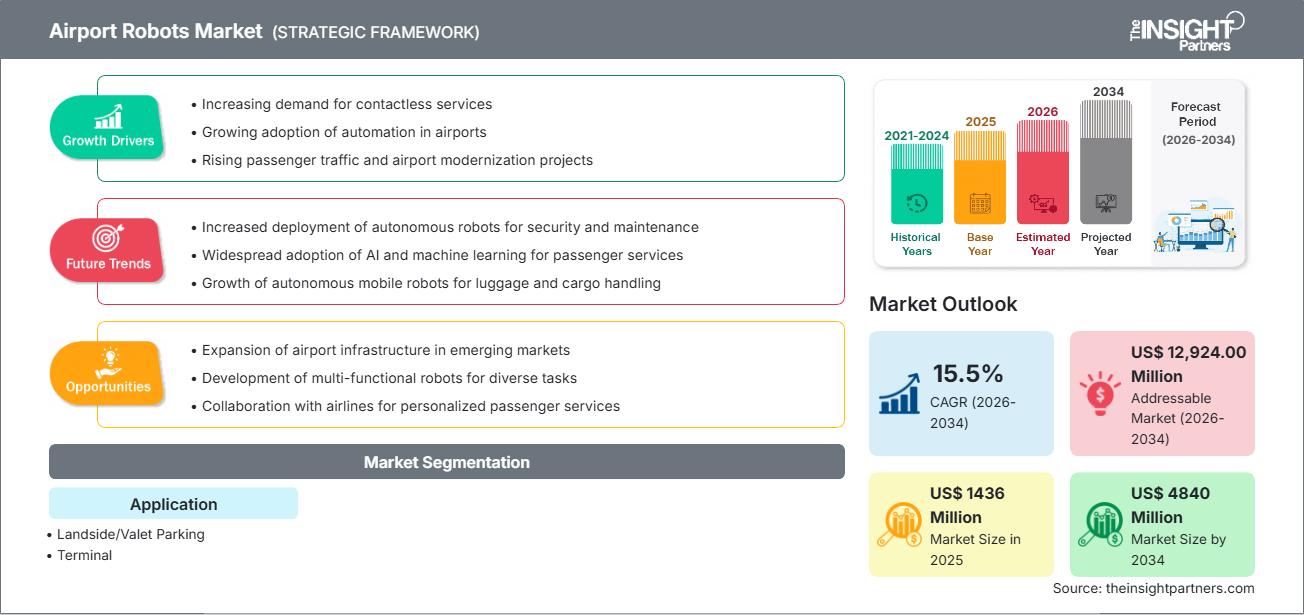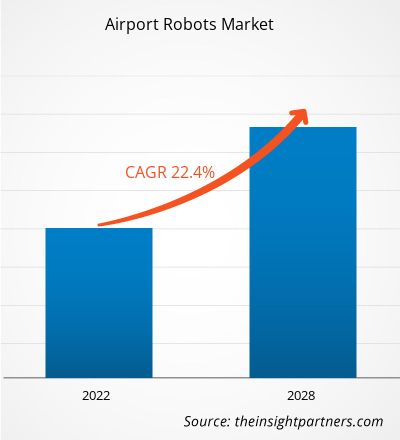La taille du marché des robots aéroportuaires devrait passer de 1436 millions de dollars US en 2025 à 4840 millions de dollars US en 2034, enregistrant un TCAC de 15,5 % au cours de la période de prévision (2026-2034).
Analyse du marché des robots aéroportuaires
L'automatisation croissante des aéroports, la sensibilisation accrue à la sécurité, la pression sur les coûts de main-d'œuvre et les exigences grandissantes en matière d'expérience passager vont stimuler la croissance du marché des robots aéroportuaires. Les aéroports déploient de plus en plus de robots de service pour l'assistance aux passagers, le nettoyage, la manutention des bagages et même la sécurité, afin de réduire leur dépendance à la main-d'œuvre humaine et d'assurer la fluidité des opérations. L'intégration de l'IA, de la vision par ordinateur, de la reconnaissance faciale et de capteurs améliorés accélère encore cette croissance.
Par ailleurs, les investissements importants dans les infrastructures aéroportuaires à travers le monde, notamment dans les marchés émergents, conjugués aux plans de modernisation des gouvernements, continuent de stimuler la demande. Les robots améliorent non seulement l'efficacité opérationnelle, mais contribuent également à une meilleure sécurité et à une hygiène accrue, devenues essentielles dans un monde post-COVID.
Aperçu du marché des robots aéroportuaires
Les robots aéroportuaires sont des systèmes robotiques spécialisés, autonomes ou semi-autonomes, déployés au sein des aéroports. Leurs tâches comprennent notamment l'orientation des passagers, les contrôles de sécurité, la manutention des bagages et le nettoyage, ainsi que diverses autres fonctions opérationnelles. Ces robots contribuent à automatiser de nombreux processus répétitifs et gourmands en ressources, améliorant ainsi l'efficacité des services et réduisant de ce fait les besoins en personnel et les risques opérationnels.
Face à l'augmentation du trafic passagers et aux attentes d'une expérience aéroportuaire fluide et sans contact, ces systèmes robotisés jouent un rôle majeur dans la modernisation du fonctionnement des aéroports. Leur adoption concerne aussi bien l'expérience des voyageurs en amont, avec des bornes d'information et d'orientation, que les opérations en aval, telles que le nettoyage, la surveillance et la logistique.
Personnalisez ce rapport selon vos besoins.
Vous bénéficierez d'une personnalisation gratuite de tous les rapports, y compris certaines parties de ce rapport, l'analyse par pays, le pack de données Excel, et vous profiterez également d'offres et de réductions exceptionnelles pour les start-ups et les universités.
Marché des robots aéroportuaires : Perspectives stratégiques

-
Découvrez les principales tendances du marché présentées dans ce rapport.Cet échantillon GRATUIT comprendra une analyse de données, allant des tendances du marché aux estimations et prévisions.
Facteurs et opportunités du marché des robots aéroportuaires
Facteurs de marché :
- Automatisation de la sécurité et détection des menaces : La recrudescence des menaces à la sécurité incite les aéroports à déployer des robots équipés de capteurs, de caméras et de systèmes de reconnaissance faciale pour surveiller les foules, détecter les anomalies et rechercher les produits de contrebande.
- Impératifs d'efficacité opérationnelle : les aéroports subissent une pression constante pour réduire les coûts de main-d'œuvre et optimiser leurs opérations ; les robots peuvent effectuer des tâches sans relâche, réduisant ainsi la dépendance à l'égard de la main-d'œuvre manuelle pour le nettoyage, la manutention des bagages et la surveillance.
- Expansion et modernisation des infrastructures : De nombreux gouvernements investissent dans la construction ou l’agrandissement d’aéroports, ce qui offre des opportunités d’intégrer la robotique dès la conception. Par exemple, le rapport d’Insight Partners souligne que la construction de nouveaux aéroports dans des pays comme la Chine et l’Inde constitue un important levier de croissance.
Opportunités de marché :
- Croissance dans les marchés émergents : le développement rapide et l’augmentation de la capacité aéroportuaire dans les économies émergentes offrent un terrain fertile pour le déploiement de robots.
- Intégration de l'IA et de la vision : L'utilisation de l'IA pour la navigation, l'interaction vocale et l'analyse des foules peut rendre les robots d'aéroport plus intelligents et accroître leur utilité pour les rôles en contact avec les passagers.
- Innovation de service : Il existe un potentiel d’expansion des cas d’utilisation, par exemple l’assistance multilingue aux passagers, le remorquage autonome des bagages, le nettoyage et les robots de voiturier autonomes.
- Partenariats avec les équipementiers robotiques : les aéroports peuvent s’associer à des fabricants de robots et à des entreprises spécialisées en intelligence artificielle pour co-développer des solutions robotiques sur mesure, optimisées pour leurs configurations, les profils de leurs passagers et les exigences réglementaires.
Analyse de segmentation du rapport sur le marché des robots aéroportuaires
La segmentation ci-dessous suit la structure généralement utilisée dans l'analyse de The Insight Partners :
Sur demande :
- Parking côté ville / service voiturier
- Terminal
Par géographie :
- Amérique du Nord
- Europe
- Asie-Pacifique
- Amérique du Sud et centrale
- Moyen-Orient et Afrique
Aperçu régional du marché des robots aéroportuaires
Les tendances régionales et les facteurs influençant le marché des robots aéroportuaires tout au long de la période prévisionnelle ont été analysés en détail par les analystes de The Insight Partners. Cette section aborde également les segments de marché et la répartition géographique des robots aéroportuaires en Amérique du Nord, en Europe, en Asie-Pacifique, au Moyen-Orient et en Afrique, ainsi qu'en Amérique du Sud et centrale.
Rapport sur le marché des robots aéroportuaires : étendue
| Attribut du rapport | Détails |
|---|---|
| Taille du marché en 2025 | 1436 millions de dollars américains |
| Taille du marché d'ici 2034 | 4840 millions de dollars américains |
| TCAC mondial (2026 - 2034) | ?15,5% |
| Données historiques | 2021-2024 |
| Période de prévision | 2026-2034 |
| Segments couverts |
Sur demande
|
| Régions et pays couverts |
Amérique du Nord
|
| Leaders du marché et profils d'entreprises clés |
|
Densité des acteurs du marché des robots aéroportuaires : comprendre son impact sur la dynamique commerciale
Le marché des robots aéroportuaires connaît une croissance rapide, portée par une demande croissante des utilisateurs finaux. Cette demande est alimentée par l'évolution des préférences des consommateurs, les progrès technologiques et une meilleure connaissance des avantages du produit. Face à cette demande grandissante, les entreprises diversifient leur offre, innovent pour répondre aux besoins des consommateurs et tirent parti des tendances émergentes, ce qui contribue à la croissance du marché.

- Découvrez un aperçu des principaux acteurs du marché des robots aéroportuaires.
Analyse des parts de marché des robots aéroportuaires par zone géographique
Le rapport de The Insight Partners fournit une ventilation régionale pour montrer comment la demande varie selon les différentes zones géographiques :
Amérique du Nord
- Part de marché et importance : Historiquement en tête en matière d'adoption grâce à une infrastructure aéronautique solide, des normes de sécurité élevées et des dépenses par habitant plus importantes en matière de technologie.
- Principaux facteurs : Conformité réglementaire, pressions sur les coûts de main-d'œuvre et intégration de la robotique dans les opérations en contact avec les passagers et dans les opérations de back-office.
Europe
- Part de marché et importance : Forte présence grâce à des aéroports modernes et à des normes de sécurité et réglementaires élevées.
- Facteurs clés : Priorité à l'automatisation, à la durabilité et à l'efficacité des opérations aéroportuaires.
Asie-Pacifique
- Trajectoire de croissance : Cette région devrait connaître une forte croissance, soutenue par un développement rapide des infrastructures aéroportuaires, une forte croissance du nombre de passagers et des politiques gouvernementales favorables.
- Tendances : Adoption de robots dotés d'IA pour l'assistance aux passagers, la sécurité et le nettoyage ; collaborations croissantes avec les entreprises de robotique.
Amérique du Sud et centrale
- Potentiel du marché : Secteur de l’aviation en croissance ; potentiel d’adoption de la robotique à mesure que de nouveaux aéroports sont construits ou modernisés.
Moyen-Orient et Afrique
- Opportunités : Projets ambitieux d’expansion aéroportuaire ; intérêt croissant pour les technologies aéroportuaires de pointe permettant de gérer un volume important de passagers et d’assurer la sécurité.
Densité des acteurs du marché des robots aéroportuaires : comprendre son impact sur la dynamique commerciale
Stratégies concurrentielles observées :
- Des partenariats entre les aéroports et les fabricants de robots pour co-créer des robots personnalisés.
- Le développement de robots plus autonomes et pilotés par l'IA qui maximisent la valeur tout en minimisant l'intervention.
- L'accent est mis sur l'interopérabilité : intégration des robots aux systèmes de gestion aéroportuaire, aux protocoles de sécurité et aux systèmes de données passagers.
- Mettre l'accent sur la fiabilité des robots, l'autonomie de la batterie et les certifications de sécurité afin de répondre aux réglementations strictes de l'aviation.
Opportunités et initiatives stratégiques :
- Les fournisseurs peuvent nouer des partenariats avec les gouvernements pour bénéficier des programmes de modernisation des aéroports.
- Co-développement de robots multilingues destinés aux passagers afin d'améliorer l'expérience client et la différenciation des services.
- Investir dans la R&D pour réduire les coûts des robots (matériel + logiciel) afin de rendre les déploiements économiquement viables même pour les petits aéroports.
Acteurs clés du marché :
- YUJIN ROBOT Co., Ltd.
- Avidbots Corp.
- CYBERDYNE INC.
- Robotique SoftBank
- Stanley Robotics SAS
- SITA
- ABB Ltd
- Groupe ECA
- LG Electronics
Autres acteurs du marché analysés au cours de l'étude :
- Robots universels A/S
- Siemens AG
- Groupe Thales
- Industries Vanderlande
- Boston Dynamics
- Honeywell International Inc.
- KUKA AG
- BlueBotics SA
- Robots UVD
Actualités et développements récents du marché des robots aéroportuaires
- Le rapport d'Insight Partners note un intérêt croissant et le déploiement de robots de sécurité dotés de capacités de reconnaissance faciale et de télédétection dans plusieurs aéroports.
- Stanley Robotics exploite des systèmes de robots voituriers autonomes dans les parkings d'aéroports, libérant ainsi de l'espace au sol et augmentant l'efficacité.
- Les aéroports des économies émergentes (par exemple, en Asie) investissent de plus en plus dans des robots d'assistance aux passagers et de nettoyage, motivés à la fois par l'expansion des capacités et le besoin de services sans contact.
- Les constructeurs automobiles développent des systèmes robotiques de nouvelle génération dotés d'une autonomie améliorée, d'une navigation par IA plus performante et d'interactions multimodales (voix + tactile) afin de répondre aux besoins de différents profils de passagers.
Rapport sur le marché des robots aéroportuaires : contenu et livrables
Le rapport « Marché des robots aéroportuaires – Prévisions jusqu’en 2034 » de The Insight Partners couvre :
- Taille et prévisions du marché mondial et régional (2021-2034)
- Dynamique du marché : facteurs, contraintes, opportunités et tendances
- Évaluation de l'impact de la COVID-19 sur l'adoption de la robotique aéroportuaire
- Analyse de segmentation : par type, application, utilisateur final, zone géographique
- Analyse PEST (Politique, Économique, Sociale, Technologique) et analyse SWOT
- Paysage concurrentiel : concentration du marché, cartographie des principaux acteurs, stratégies
- Profils détaillés des principaux acteurs : SITA, SoftBank Robotics, Stanley Robotics, ABB, LG Electronics, CYBERDYNE, Yujin Robot, etc.
- Analyse historique (2 ans), année de base, prévision (7 ans) avec TCAC
- Analyse PEST et SWOT
- Taille du marché Valeur / Volume - Mondial, Régional, Pays
- Industrie et paysage concurrentiel
- Ensemble de données Excel
Rapports récents
Témoignages
Raison d'acheter
- Prise de décision éclairée
- Compréhension de la dynamique du marché
- Analyse concurrentielle
- Connaissances clients
- Prévisions de marché
- Atténuation des risques
- Planification stratégique
- Justification des investissements
- Identification des marchés émergents
- Amélioration des stratégies marketing
- Amélioration de l'efficacité opérationnelle
- Alignement sur les tendances réglementaires






















 Obtenez un échantillon gratuit pour - Marché des robots aéroportuaires
Obtenez un échantillon gratuit pour - Marché des robots aéroportuaires